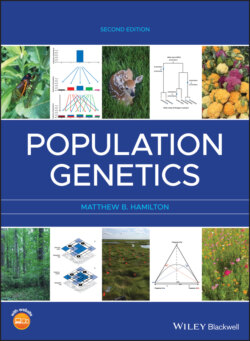Читать книгу Population Genetics - Matthew B. Hamilton - Страница 51
Interact box 2.4 Estimating genotypic disequilibrium
ОглавлениеIn practice, the recombination fraction for two loci can be measured by crossing a double heterozygote with a double homozygote and then counting the recombinant gametes. However, this basic experiment cannot be carried out unless individuals can be mated in controlled crosses, excluding many, if not most, species. For two diploid loci, disequilibrium can occur between loci at two alleles positioned on the same chromosome, as well as between loci at two alleles positioned on different chromosomes (Weir 1996). With observed genotype data from pairs of loci where the phase of alleles or gamete organization is unknown, these latter two types of between‐locus disequilibrium cannot be distinguished but they can be considered together as genotypic disequilibrium (Rogers and Huff 2009).
An approximate means to test for gametic equilibrium is to examine the joint frequencies of genotypes at pairs of loci. If there is independent segregation at the two loci, then the genotypes observed at one locus should be independent of the genotypes at the other locus. Such contingency table tests are commonly employed to determine whether genotypes at one locus are independent of genotypes at another locus.
Contingency table tests involve tabulating counts of all genotypes for pairs of loci. In Table 2.14, genotypes observed at two microsatellite loci (AC25‐6#10 and AT150‐2#4) within a single population (the Choptank River) of the fish Morone saxatilis are given. The genotypes of 50 individuals are tabulated with alleles at each locus are represented with numbers. For example, there were 15 fishes that had a 22 homozygous genotype for locus AC25‐6#10 and also had a 44 homozygous genotype for locus AT150‐2#4. This joint frequency of homozygous genotypes is unlikely if genotypes at the two loci are independent, in which case the counts should be distributed randomly with respect to genotypes.
In the striped bass case shown here, null alleles (microsatellite alleles that are present in the genome but not reliably amplified by PCR) are probably the cause of fewer than expected heterozygotes that lead to a non‐random joint distribution of genotypes (Brown et al. 2005). Thus, the perception of gametic disequilibrium can be due to technical limitations of genotyping techniques in addition to population genetic processes such as reduced recombination (or linkage), self‐fertilization, consanguineous mating, and mixing of diverged populations that cause actual gametic disequilibrium.
Genepop on the Web can be used to construct genotype count tables for pairs of loci and carry out statistical tests that compare observed to those expected by chance. Instructions on how to use Genepop and an example of striped bass microsatellite genotype data set in the Genepop format are available on the text website along with a link to the Genepop site.
Table 2.14 Joint counts of genotype frequencies observed at two microsatellite loci in the fish Morone saxatilis . Alleles at each locus are indicated by numbers (e.g. 12 is a heterozygote and 22 is a homozygote).
| Genotype at locus AC25‐6#10 | ||||||
|---|---|---|---|---|---|---|
| Genotype at locus AT150‐2#4 | 12 | 22 | 33 | 24 | 44 | Row totals |
| 22 | 0 | 0 | 1 | 0 | 0 | 1 |
| 24 | 1 | 4 | 0 | 4 | 1 | 10 |
| 44 | 2 | 15 | 0 | 0 | 0 | 17 |
| 25 | 0 | 3 | 0 | 0 | 0 | 3 |
| 45 | 0 | 8 | 0 | 1 | 0 | 9 |
| 55 | 1 | 1 | 0 | 0 | 0 | 2 |
| 26 | 0 | 1 | 0 | 2 | 0 | 3 |
| 46 | 1 | 3 | 0 | 0 | 0 | 4 |
| 56 | 0 | 0 | 0 | 1 | 0 | 1 |
| Column totals | 5 | 35 | 1 | 8 | 1 | 50 |
